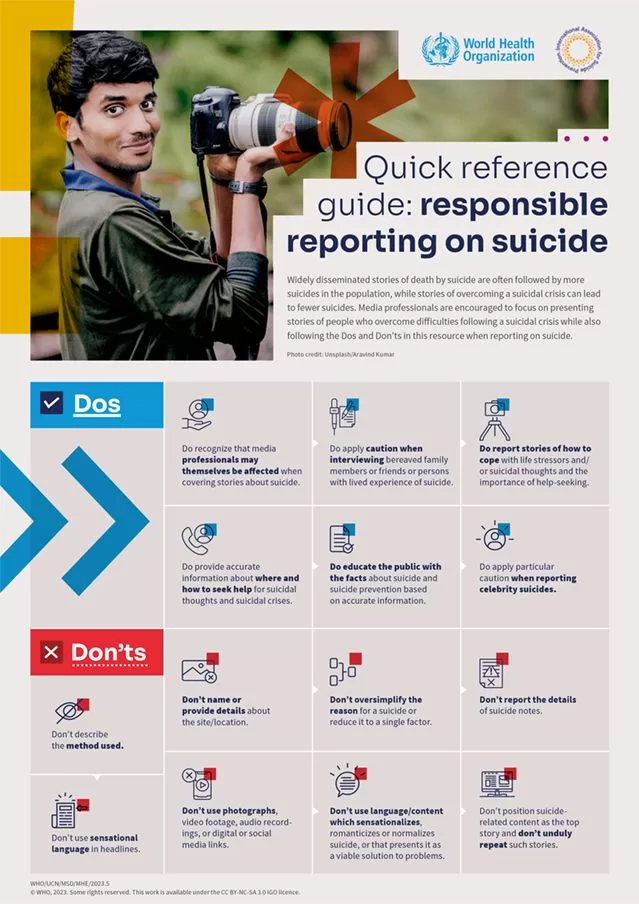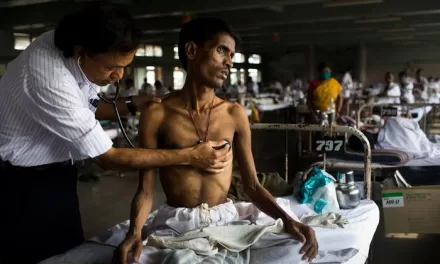“Changing the narrative on suicide”
Key facts
- More than 720 000 people die due to suicide every year.
- Suicide is the third leading cause of death among 15–29-year-olds.
- Seventy-three per cent of global suicides occur in low- and middle-income countries.
- The reasons for suicide are multi-faceted, influenced by social, cultural, biological, psychological, and environmental factors present across the life-course.
- For every suicide there are many more people who attempt suicide. A prior suicide attempt is an important risk factor for suicide in the general population.
Suicide is a major public health challenge, with more than 700 000 deaths each year globally. Each suicide has far-reaching social, emotional, and economic consequences, and deeply affects individuals and communities worldwide.
Suicide does not just occur in high-income countries but is a global phenomenon in all regions of the world. In fact, close to three quarters (73%) of global suicides occurred in low- and middle-income countries in 2021.
The triennial theme for World Suicide Prevention Day for 2024-2026 is “Changing the Narrative on Suicide” with the call to action “Start the Conversation”. This theme aims to raise awareness about the importance of reducing stigma and encouraging open conversations to prevent suicides. Changing the narrative on suicide is about transforming how we perceive this complex issue and shifting from a culture of silence and stigma to one of openness, understanding, and support.
The call to action encourages everyone to start the conversation on suicide and suicide prevention. Every conversation, no matter how small, contributes to a supportive and understanding society. By initiating these vital conversations, we can break down barriers, raise awareness, and create better cultures of support.
This theme also emphasizes the need to prioritize suicide prevention and mental health in policy making, calling for government action. Changing the narrative requires advocating for policies that prioritize mental health, increase access to care, and provide support for those in need.
World Suicide Prevention Day (WSPD) was established in 2003 by the International Association for Suicide Prevention in conjunction with the World Health Organization (WHO). The 10 September each year aims to focus attention on the issue, reduces stigma and raises awareness among organizations, governments, and the public, giving a singular message that suicides are preventable.
Who is at risk?
The link between suicide and mental disorders (in particular, depression and alcohol use disorders) and a previous suicide attempt is well established in high-income countries. However, many suicides happen impulsively in moments of crisis with a breakdown in the ability to deal with life stresses, such as financial problems, relationship disputes, or chronic pain and illness.
In addition, experiencing conflict, disaster, violence, abuse or loss and a sense of isolation are strongly associated with suicidal behaviour. Suicide rates are also high among vulnerable groups who experience discrimination, such as refugees and migrants; indigenous peoples; lesbian, gay, bisexual, transgender, intersex (LGBTI) persons; and prisoners.
Prevention and control
There are several measures that can be taken at population, sub-population and individual levels to prevent suicide and self-harm. LIVE LIFE, WHO’s initiative for suicide prevention, recommends the following key effective evidence-based interventions:
- limit access to the means of suicide (e.g. pesticides, firearms, certain medications);
- interact with the media for responsible reporting of suicide;
- foster socio-emotional life skills in adolescents; and
- early identify, assess, manage and follow up anyone who is affected by suicidal behaviours.
These need to go hand-in-hand with the following foundational pillars: situation analysis, multisectoral collaboration, awareness raising, capacity building, financing, surveillance and monitoring and evaluation.
Suicide prevention efforts require coordination and collaboration among multiple sectors of society, including the health sector and other sectors such as education, labour, agriculture, business, justice, law, defence, politics and the media. These efforts must be comprehensive and integrated given the multifaceted nature of suicide.
Communities also play a crucial role in preventing suicide. The WHO community engagement toolkit guides communities in identifying priorities and implementing activities according to local contexts.
Challenges and obstacles
Stigma and taboo
Stigma, particularly surrounding mental disorders and suicide, means many people thinking of taking their own life or who have attempted suicide are not seeking help and are therefore not getting the help they need. The prevention of suicide has not been adequately addressed due to a lack of awareness of suicide as a major public health problem and the taboo in many societies to openly discuss it. To date, only a few countries have included suicide prevention among their health priorities and only 38 countries report having a national suicide prevention strategy.
Raising community awareness and breaking down the taboo is important for countries to make progress in preventing suicide.
Data quality
Globally, the availability and quality of data on suicide and self-harm is poor. Only some 80 WHO Member States have good-quality vital registration data that can be used directly to estimate suicide rates. This problem of poor-quality mortality data is not unique to suicide, but given the stigma surrounding suicide – and the illegality of suicidal behaviour in some countries – it is likely that under-reporting and misclassification are greater problems for suicide than for most other causes of death.
Improved surveillance and monitoring of suicide and self-harm are required for effective suicide prevention strategies. Cross-national differences in the patterns of suicide, and changes in the rates, characteristics and methods of suicide, highlight the need for each country to improve the comprehensiveness, quality and timeliness of their suicide-related data. This includes vital registration of suicide, hospital-based registries of self-harm and nationally representative surveys collecting information about self-reported self-harm.













